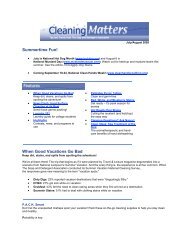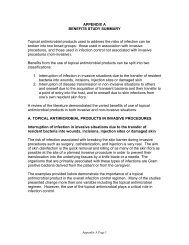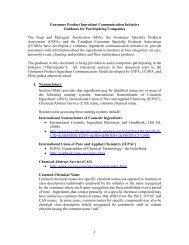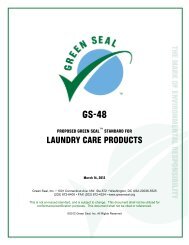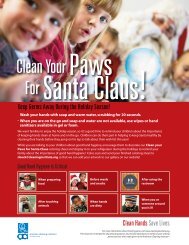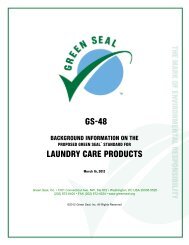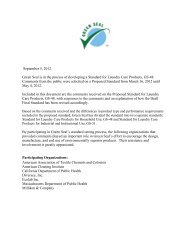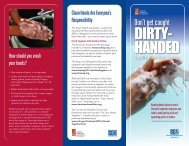subchapter c -- federal hazardous substances act regulations
subchapter c -- federal hazardous substances act regulations
subchapter c -- federal hazardous substances act regulations
You also want an ePaper? Increase the reach of your titles
YUMPU automatically turns print PDFs into web optimized ePapers that Google loves.
16 CFR Ch. II (1–1–05 Edition) – proposed modification – 6/25/06<br />
(4) Signal word and statements of hazard<br />
— capital letters. The signal word, the word<br />
”poison” if required (see § 1500.129), and the<br />
statement of principal hazard or hazards shall<br />
be in capital letters.<br />
(5) Multiple statement of hazard — type<br />
size and style. All statements of principal<br />
hazard or hazards on a label shall appear in the<br />
same size and style of type, and shall appear in<br />
the same color or have the same degree of<br />
boldness.<br />
(6) Accompanying literature containing<br />
directions for use. Where literature<br />
accompanying the package of a <strong>hazardous</strong><br />
substance has directions for use, written or<br />
otherwise, section 2(n) of the Act requires the<br />
literature to bear cautionary labeling.<br />
(i) All such cautionary labeling shall be in<br />
reasonable proximity to any direction for use<br />
and shall be placed together within the same<br />
general area.<br />
(ii) The type size of such cautionary<br />
labeling shall be reasonably related to the type<br />
size of any other printed matter in the<br />
accompanying literature and must be in<br />
conspicuous and legible type by typography,<br />
layout, or color with other printed matter on<br />
the label. The signal word and statement of<br />
principal hazard or hazards shall appear in<br />
capital letters.<br />
(d) Conspicuousness — contrast. To<br />
satisfy the requirement that cautionary labeling<br />
statements appear in conspicuous and legible<br />
type which is in contrast by typography,<br />
layout, or color with the other printed matter<br />
on the label, such statements shall conform to<br />
the following requirements:<br />
(1) Color. Where color is the primary<br />
method used to achieve appropriate contrast,<br />
the color of any cautionary labeling statement<br />
shall be in sharp contrast with the color of the<br />
background upon which such a statement<br />
appears. Examples of combinations of colors<br />
which may not satisfy the requirement for<br />
sharp contrast are: black letters on a dark blue<br />
or dark green background, dark red letters on a<br />
light red background, light red letters on a<br />
reflective silver background, and white letters<br />
on a light gray or tan background.<br />
(2) Interference with conspicuousness —<br />
labeling design, vignettes, or other printed<br />
material. For cautionary information<br />
appearing on panels other than the principal<br />
display panel, the label design, the use of<br />
-- 84 --<br />
vignettes, or the proximity of other labeling or<br />
lettering shall not be such that any cautionary<br />
labeling statement is obscured or rendered<br />
inconspicuous.<br />
(e) Collapsible metal tubes. Collapsible<br />
metal tubes containing <strong>hazardous</strong> <strong>substances</strong><br />
shall be labeled so that all cautionary labeling<br />
required by the Act appears as close to the<br />
dispensing end of the container as possible.<br />
The placement and conspicuousness of these<br />
statements shall conform to the provisions of<br />
paragraphs (b), (c), and (d) of this section.<br />
(f) Unpackaged <strong>hazardous</strong> <strong>substances</strong>.<br />
Where pr<strong>act</strong>icable, unpackaged <strong>hazardous</strong><br />
<strong>substances</strong> intended, or distributed in a form<br />
suitable, for use in or around a household or<br />
by children shall be labeled so that all items of<br />
information required by the Act appear upon<br />
the article itself. In instances where this is<br />
impr<strong>act</strong>icable (for example, because of the size<br />
or nature of the article), the required<br />
cautionary labeling must be displayed by<br />
means of a tag or other suitable material that is<br />
no less than five square inches in area and is<br />
securely affixed to the article so that the<br />
labeling will remain attached throughout<br />
conditions of merchandising and distribution<br />
to the ultimate consumer. The placement and<br />
conspicuousness of all cautionary labeling<br />
appearing on such a tag or material, or on an<br />
unpackaged article, shall conform to the<br />
provisions of paragraphs (b), (c), and (d) of<br />
this section. For the purposes of determining<br />
the proper type size to use on a tag or other<br />
material, the area of one side of the tag or<br />
other material shall be the area of the principal<br />
display panel.<br />
(g) Exemptions. All requirements of the<br />
Act are satisfied by compliance with this §<br />
1500.121. However, exemptions can be<br />
granted under section 3(c) of the Act and §<br />
1500.83, or under the provisions of another<br />
statute should this section be incorporated in<br />
<strong>regulations</strong> under another statute. Section<br />
1500.82 contains the requirements for<br />
exemption requests under the Federal<br />
Hazardous Substances Act.<br />
(h) Effective date. The provisions of this<br />
rule apply to <strong>hazardous</strong> <strong>substances</strong> bearing<br />
labels printed two years after promulgation of<br />
the regulation. Labels printed prior to the<br />
effective date of this rule may be applied until<br />
not later than three years after promulgation of<br />
the regulation. This rule applies to all<br />
Deleted: instead of a signal word<br />
Deleted: December 30, 1985<br />
Deleted: December 28, 1987



